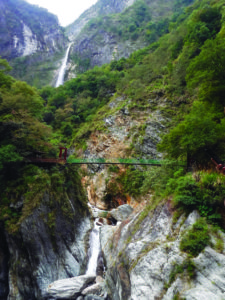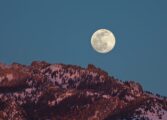By Page H. Gifford, Correspondent
Fluvanna residents Sue and Al Mink often travel to Europe, living three months at a time in various places, but thought it was about time to explore other places outside Europe.
“We wanted to broaden our horizon s,” said Sue Mink, who agreed with her husband that Taiwan would be the ideal place to visit. “Also, Al loves to bicycle, and we’d heard that it’s some of the best biking in the world, it’s affordable and the people are very nice.”
s,” said Sue Mink, who agreed with her husband that Taiwan would be the ideal place to visit. “Also, Al loves to bicycle, and we’d heard that it’s some of the best biking in the world, it’s affordable and the people are very nice.”
She said the best part of the trip was the people.
“They are the friendliest people on earth. Every day we had people telling us ‘Welcome to Taiwan!’ Our neighbors in our apartment building invited us to dinner, and we got to the point where we hesitated to ask directions because people would go way out of their way to make sure that we found where we were going. No crime, no worries about pick-pocketing, nothing, just lovely, honest, warm people.”
Also, Mink said, “It’s a spectacularly beautiful country.” One of the many places they spent time in was Taroko National Park. Originally part of the Japanese Empire, it was established in 1937, but after Japan’s defeat in World War II, it became part of the Republic of China.
The park is a place of pristine, natural beauty, with a flawless coastline, canyons, gorges and blue lagoons. Carved out of ocean beds, it is made of limestone.
Every place they visited looked like the cover of National Geographic, she said.
“Taroko Gorge was every bit as beautiful as Yosemite if not more so, and the entire east coast is amazing,” Mink said.
Living there, they had a chance to partake in everyday life. Mink said they loved the metro system in Taipei; it was clean, inexpensive, and provided a look into the future.
“The street markets were a lot of fun – we had a small one right outside our apartment building. I got spoiled and when you can get great food for under $2 a meal, it’s hard to be motivated to cook,” she said. “In fact, we learned that few Taiwanese actually know how to cook. The best food was at the street markets and little hole in the wall family restaurants.”
They also wandered through Dadaocheng, the area that retains the marks of Japanese colonialism, and where they ate some of the best sushi on the ground floor of the Yongle market.
 She added that some apartments in Taipei don’t even have kitchens and that their apartment only had one burner. Homes may have what they call a kitchen, which consists of a hot plate in the counter and a sink. People in Taiwan eat out because the cost is so cheap compared with the rest of the world.
She added that some apartments in Taipei don’t even have kitchens and that their apartment only had one burner. Homes may have what they call a kitchen, which consists of a hot plate in the counter and a sink. People in Taiwan eat out because the cost is so cheap compared with the rest of the world.
“I’m ruined for life for sashimi and sushi because it was so fresh and so good,” Mink said. She described other native food that she fell in love with, including the famous Taiwanese beef noodle soup and scallion pancakes with a fried egg inside, served with a little duck sauce and hot sauce – all for about $1.20.
“However, there was some food that I wasn’t as fond of – they seem to like pig intestines – too chewy for my taste – and they also have ‘stinky tofu’ – tofu that is marinated and smells like bad sneakers. We ate it on a challenge. Once,” she laughed.
“Taipei is one of the most fascinating places we’ve ever explored,” she said. As someone who has lived in various cities, Mink said Taipei is an extremely easy city to live in – easy to navigate and get around, and set up for convenient living.
One of the drawbacks to living in Taiwan, and their biggest adjustment, was the size of the apartment.
“Our entire two-bedroom apartment could fit into our eat-in kitchen here at Lake Monticello. Asian living quarters are small. It’s very nice to get home and have room,” she said.
The other thing they discovered was difficult was the price of anything dairy. “Milk was about $9 a gallon, and it was nearly impossible to find cheese that wasn’t super processed. We started to drink a lot more tea, because we like a lot of milk in our coffee,” she said.
The other interesting aspect of city living is that the garbage trucks play music to call people to bring out their trash. At first they couldn’t imagine what it was. The sounds reminded them of the old Good Humor ice cream trucks that would tour neighborhoods.
In addition, Taipei is very, very hot and rainy. “It was uncomfortable when we got there the end of August – but by the time we left in mid-November, it was high 70s and low 80s – perfect,” she said.
“One of the most interesting things about Taiwan were the temples. You always knew when you were getting close to one because you could smell the incense. They had beautiful Koji ceramics on the roof,” she said, then went on to describe their religious rituals. “Inside, it was very interesting to watch the people pray. They would hold the incense up to their forehead and bow three times. Sometimes they’d throw two red crescent-shaped wooden objects called jiaobai while they prayed. Depending on how they fell, it told them answers to their prayers. They also would pull sticks that had a number on them from a bowl after prayers. The numbers would refer to a little drawer in a cabinet in the back of the temple. Inside the drawers would be written fortunes or guidance from the gods.”
Sometimes they would see temple parades, in which people would carry large effigies of the gods through the streets to the temples. Almost like a Taiwanese Mardi Gras, they would throw firecrackers and bang drums, resulting in a little bit of bedlam in the streets.
For those visiting for a short time, unlike the Minks’ three-month stint, she recommended Taroko National Park and particularly the Taroko Gorge as a must-see. She said the government-run hotel, called Silks, is beautiful and guests can take tours right from the hotel. She also highly recommended going down the eastern coast for a few days – either by car, bus or by bicycle. It’s one of the prettiest places she and her husband have ever seen.
In Taipei, one of the best things to do is just walk the streets, she said. Duck into temples. Spend time in the markets. She would try to do the jade market that is held every weekend underneath the elevated highway. They also wandered the streets around Dongshan for a real “old Taipei” market feel. She suggested taking the gondola up into the mountains.
“It’s part of the Taipei metro system and it’s a half hour of spectacular views of the city that drops you off in tea fields where you can try some of the best tea in the world,” she said. “Take the super fast elevator up Taipei 101, one of the tallest buildings in the world, and look down on the city from heights that will make you think you’re in an airplane. And don’t miss out on the Palace Museum, which holds the greatest collection of Chinese art in the world.
“It’s a bustling, busy city, but it’s got a kind, warm heart,” Mink continued. “People smile and wave, help old people cross the street, and I don’t think I ever saw an angry word exchanged on the street. People smile and watch out for one another. It would be nice if more of the world would have the heart of Taiwan.”




